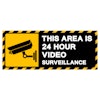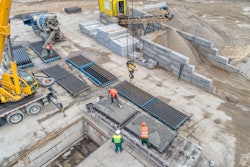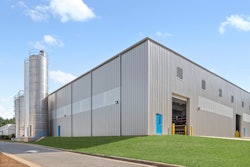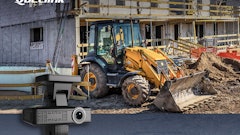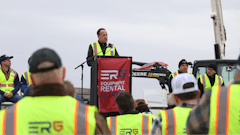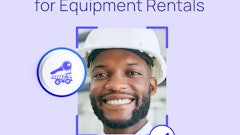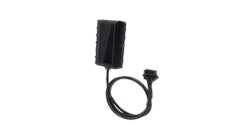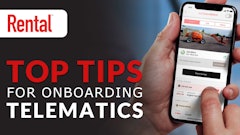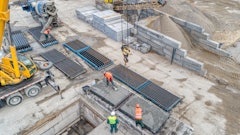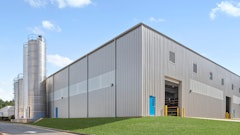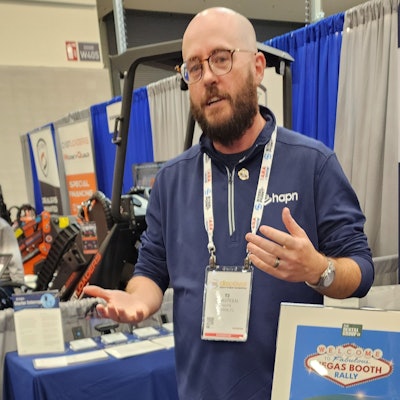
We caught up with TJ Chasteen, product manager, at Hapn, at the 2025 ARA Show in Las Vegas to learn more about the company. Hapn produces GPS-based asset tracking hardware and software for many industries, including construction and rental. Hapn engineers develop the software and have a number of unique problem solvers for heavy equipment theft.
Q: What makes Hapn different from other asset trackers out there?
 Hapn
Hapn
We pride ourselves on developing features based on how customers need them, and so we're directly talking to our customers, getting feedback on, ‘do you need a feature to do this? Do you need a feature to dispatch that kind of thing?’
We also directly integrate with a lot of partners, such as rentals. We have an integration with several others that allows customers to use telematics coming from the hardware, and they get it directly into their rental application to write contracts with knowledge of active hours on the machine. And we've got some really cool new features that are coming in.
Q: What’s new at the show?
Brand new for ARA is our dash camera that is a GPS tracker with an outward-facing and inward-facing camera. What that allows you to do is a get huge insurance savings on your service trucks and fleet vehicles. But it's also going to help you monitor any event that might happen, protect your equipment.
It’s going to help if a crash happens. It's automatically going to log the crash, the location and query video, so you'll be able to see exactly what happened, be able to resolve it with your staff.
And if you have new drivers that you've got a probationary period on, the driver monitoring let’s you know if they're doing anything like driving distracted, using their phone, smoking in the cab, anything like that. It automatically records and drags that video as well, all in our application, so you're able to connect to that in its location as it's moving.
It's a great way to sort of physically see what is happening, as well as plotting it on a map. A lot of times with telematics, you're kind of disconnected from what's actually happening. Guys looking at a map and seeing it online, this kind of bridges that gap and allows you to see what was really there.
All our machines are also releasing a new starter interface, which we're really excited about. This really applies to theft prevention. So any customers who -- no matter what industry, no matter what they're renting out, what piece of equipment -- everybody gets worried about something walking off from a lot or from a customer site.
What this allows you to do is set a schedule that will prevent the tracker itself from starting during a set period of time. So you can go in and say, ‘You know what, from 7 p.m. to 5 a.m. this equipment doesn't start,’ and with that in place, that vehicle equipment will not turn on unless the person shows up with a flatbed.
Q: What else are attendees finding interesting at the show?
Another thing that I think is a pretty unique feature is ghost tracking. This is focused on theft for future, and our hardwired truck. Here, we have our GV57; it's our most popular model, it allows you to wire to the equipment and you get all sorts of telematics data, things like that.
Well, the ghost tracker allows you to pair it with one of our batteries, because our customers were having issues where people knew that GPS was on their equipment. You know, if you see a $150,000 excavator, you're going to assume somebody's tracking, so they're (thieves are) coming in and ripping off the tracker, which kind of leaves the client out of luck.
The way this tracking works is these two devices pair via Bluetooth to each other, and while they're paired, this one (the ghost tracker) does nothing. It's idle. You hide them in the cab, somewhere, wherever, somebody comes in and tears this (the more visible tracker) out.
As soon as the connection breaks, this (ghost tracker) starts tracking. So now you're still able to recover the equipment.
The other side of theft that doesn't be talked about enough, I think, is the preventative side of it. The reason why convenience stores, for example, have visible cameras is a lot of people, when they walk in, if they see a camera, they're not going to steal. Yeah, the camera isn't there to catch (criminals), it's to deter. You can utilize this tracker as a deterrent. If you don't try to hide this one, you're going to deter something. And then the people who are willing to tear it out are still going to get caught.
We're also launching a brand-new tracker that is for our heavy machinery. It's for advanced telematics. It's got 18 different inputs, so it allows you to connect to the actual machine computer, and it reads the data from the machine. A good way to think of it is, our GPS trackers, they measure speed because they have an accelerometer. This measures speed because the machine tells it how fast it's moving. So it's more exact data, more accurate. It also gives you sort of a wider swath of data; so you're pulling things like engine oil, temperature, engine air flow; really advanced data that applies to the machines.
We also have really wide capability and compatibility via can bus. And it's also it's got a dual can bus, which what that means is anything that has basically two engines. So I think of a scissor lift where you have to start the motor, but you also have an entirely separate motor on the bucket itself.
It connects to both of those, so I can see whether the whole machine is running or if just the lift is up, and that let’s you get the data from the two separate sources. So that's a pretty big win for customers from that perspective.
We've got advanced telematics. We track attachments, all of that stuff. And we think, with our ability to add new items, at a relatively frequent pace based on the customer feedback, it sort of positions us in a way that we can be a one-to-one relationship with the customer, rather than, you know, you're not just going to be another cog in the machine. If you have a need, you're going to get to talk to me.
Q: Can you talk about compatibility across equipment and brands?
The great thing is, most of our, all of our devices, are, in essence, universal battery-powered devices. You just slap them on. The hard-wired tracker is connected to just power. But asking about equipment types, you bring up something that I wanted to talk about, and that's our ongoing project to integrate with OEMs.
A lot of rental companies, they'll buy a new Kubota fleet. Well, Kubota includes tracking for the first year for free. We don't want customers to lose out on that. We don't expect them to ignore that. So we're working on integrating with these OEMs to pull that location data into our app. So if you log in and you've got, you know, 100 older machines that have had trackers, you'll see those, but you're also going to see your 100 brand new Kubota machines with the Kubota tracker, you don't even need to install. But, yeah, compatibility wise, as long as you've got a powered circuit or a metal surface, we can attach a tracker.


